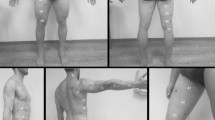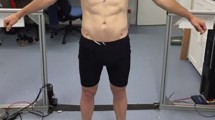Abstract
OBJECTIVE: This study compares skinfold caliper and sonographic measurements of the amount and distribution of subcutaneous adipose tissue teenagers gain during pregnancy to test three hypotheses: (1) skinfold caliper and sonographic measurements of subcutaneous adiposity are highly correlated in pregnancy; (2) the extent to which the skinfold caliper heads compact the tissues increases during gestation; and (3) skinfold caliper measurements yield a smaller estimate of the amount of subcutaneous adipose tissue gained during gestation than do sonographic measurements.
METHODS: We studied 28 primiparous teenagers at 10.7±2.8 and 29.6±1.8 weeks gestation. At both study visits subcutaneous adipose tissue thickness was measured at six body sites, first by skinfold caliper and then by ultrasound. Taking the nearly compression-free sonographic measurements as the standard, we quantified the extent to which the skinfold caliper heads compacted the tissues at each measurement site by computing the percentage compression: (mean adipose tissue thickness by ultrasound−(0.5×mean adipose tissue thickness by caliper)/mean adipose tissue thickness by ultrasound)×100. Pearson correlations and paired t-tests were used to compare the skinfold caliper and sonographic measurements.
RESULTS: Hypothesis 1 was supported; the skinfold caliper and sonographic measurements were highly correlated at both study visits. Hypothesis 2 was not supported; between study visits caliper-related tissue compression decreased at measurement sites on the trunk and remained the same at measurement sites on the extremities. Hypothesis 3 was also refuted; the skinfold caliper-derived estimate of the amount of subcutaneous adipose tissue gained on the trunk exceeded the corresponding sonographic determination. As anticipated, the skinfold caliper measurements indicated that adipose tissue was stored more rapidly on the trunk than the extremities, but the opposite pattern emerged when the sonographic measurement technique was used.
CONCLUSIONS: The results of this study challenge the notion that pregnant women store adipose tissue preferentially on the trunk and suggest that pregnancy-related changes in the regional distribution of maternal body fat based on skinfold caliper measurements should be interpreted cautiously.
This is a preview of subscription content, access via your institution
Access options
Subscribe to this journal
Receive 12 print issues and online access
$259.00 per year
only $21.58 per issue
Buy this article
- Purchase on Springer Link
- Instant access to full article PDF
Prices may be subject to local taxes which are calculated during checkout
Similar content being viewed by others
References
Parker JD . Prenatal weight gain and postpartum weight retention: a delicate balance Am J Public Health 1993 83: 1082–1084.
Lederman SA . The effect of pregnancy weight gain on later obesity Obstet Gynecol 1993 82: 148–155.
Scholl TO, Hediger ML . Weight gain, nutrition, and pregnancy outcome: findings from the Camden study of teenage and minority gravidas Sem Perinat 1995 19: 171–181.
Stevens-Simon C, McAnarney ER . Adolescent maternal weight gain and low birth weight: a multifactorial model Am J Clin Nutr 1988 47: 948–953.
Stevens-Simon C, Roghmann KJ, McAnarney ER . Weight gain in adolescent pregnancy. Part I. Relationship to maternal age and infant birth weight. Pediatrics 1993 92: 805–809.
Kepple K, Taffel S . Pregnancy-related weight gain and retention: implications of 1990 Institute of Medicine guidelines Am J Public Health 1993 83: 1100–1103.
Troiano RP, Flegal KM . Overweight children and adolescents: description, epidemiology, and demographics Pediatrics 1998 101: 497–504.
Taggart NR, Holliday RM, Billewicz WZ, Hytten FE, Thompson AM . Changes in skinfolds during pregnancy Br J Nutr 1967 21: 439–451.
Forsum E, Sadurskis A, Wager J . Estimation of body fat in healthy Swedish women during pregnancy and lactation Am J Clin Nutr 1989 50: 465–473.
Robertson EG . Oedema in normal pregnancy J Reprod Fert 1969 9 (Suppl): 27–36.
Fanelli MT, Kuczmarski RJ . Ultrasound as an approach to assessing body composition Am J Clin Nutr 1984 39: 703–709.
Kuczmarski RJ, Fanelli MT, Koch GG . Ultrasonic assessment of body composition in obese adults: overcoming the limitations of the skinfold caliper Am J Clin Nutr 1987 45: 717–724.
Bland JM, Altman DG . Statistical methods for assessing agreement between two methods of clinical measurement Lancet 1986 i: 307–310.
Stevens-Simon C, Wallis J, Allan-Davis J . Antecedents of preterm delivery among adolescents: relationship to type of prenatal care J Matern Fetal Med 1995 4: 186–193.
Stevens-Simon C, Roghmann KJ, McAnarney ER . Self-reported prepregnant weight and weight gain: relationship to body habitus and maternal age J Am Diet Assoc 1992 92: 85–87.
Norusis MJ . Statistical Package for the Social Sciences SPSS/PC+SPSS Inc. Chicago, IL 1990.
Sohlstrom A, Forsum E . Changes in adipose tissue volume and distribution during reproduction in Swedish women as assessed by magnetic resonance imaging Am J Clin Nutr 1995 61: 287–295.
Paxton A, Lederman SA, Heymsfield SB, Wang J, Thornton JC, Pierson RN . Anthropometric equations for studying body fat in pregnant women Am J Clin Nutr 1998 67: 104–110.
Sohlstrom A, Forsum E . Changes in total body fat during the human reproductive cycle as assessed by magnetic resonance imaging, body water dilution, and skinfold thickness: a comparison of methods Am J Clin Nutr 1997 66: 1315–1322.
Acknowledgements
The authors wish to thank the staff and the patients of the Colorado Adolescent Maternity Program for their help with data collection. Supported in part by grant no. DK 48520-04 5 P30; NIH pilot grant from the Clinical Nutrition Center, University of Colorado Health and Sciences Center, Denver, Colorado; grant no. 5 MO1RR00069 General Clinical Research Centers Program, National Center for Research Resources, NIH.
Author information
Authors and Affiliations
Rights and permissions
About this article
Cite this article
Stevens-Simon, C., Thureen, P., Barrett, J. et al. Skinfold caliper and ultrasound assessments of change in the distribution of subcutaneous fat during adolescent pregnancy. Int J Obes 25, 1340–1345 (2001). https://doi.org/10.1038/sj.ijo.0801685
Received:
Revised:
Accepted:
Published:
Issue Date:
DOI: https://doi.org/10.1038/sj.ijo.0801685
Keywords
This article is cited by
-
Advances in assessing body composition during pregnancy
European Journal of Clinical Nutrition (2018)
-
Body composition changes in pregnancy: measurement, predictors and outcomes
European Journal of Clinical Nutrition (2014)
-
Lean and Fat Mass Loss in Obese Patients Before and After Roux-en-Y Gastric Bypass: A New Application for Ultrasound Technique
Obesity Surgery (2012)
-
Difficulty in losing weight by behavioral intervention for women with Trp64Arg polymorphism of the β3-adrenergic receptor gene
International Journal of Obesity (2003)



